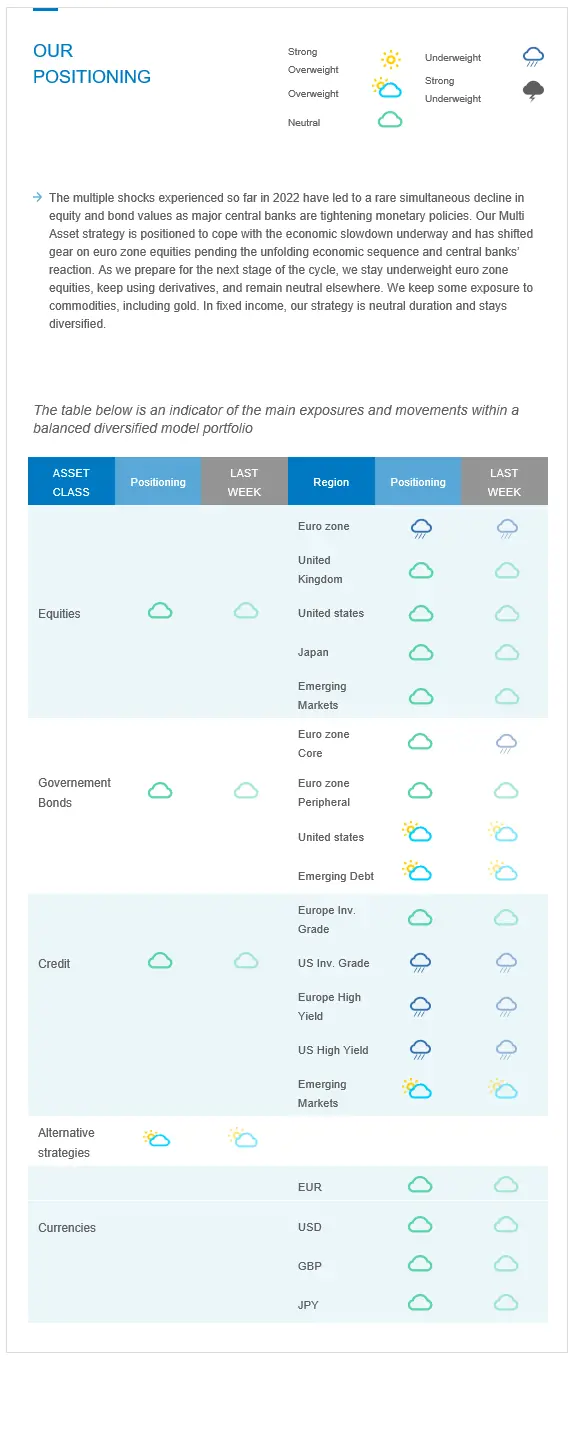Last week in a nutshell
- The US economy added 528K jobs, much higher than the forecasted 250K, showing that the economy is not cooling yet despite the Federal Reserve’s efforts.
- All but 1 of the nine-member of the Monetary policy committee of the Bank of England voted for raising rates by 50bps to 1.75%. UK inflation is running high, also due to energy prices.
- China published leading indicator figures on manufacturing and services activities. While the short-term shock of the latest round of COVID-19 outbreaks is fading, Q3 will be a crucial period to get the economy back on track. The growth target has now become “the best possible outcome”.
What’s next?
- Inflation will be in focus. Key markets, such as the US, China, Japan and some European countries will release either CPI, PPI or inflation figures.
- The UK will publish a series of activity-related data, including GDP growth, balance of trade and business investment.
- In the US, the University of Michigan will release its preliminary readings on consumer sentiment, current conditions, and inflation expectations.
- The earnings season will move on to European and Japanese corporates as almost all S&P 500 companies have published their results.
Investment convictions
Core scenario
- Our exposure keeps an overall broadly balanced allocation before positioning for the next stage of the cycle, whether it be a soft or a hard landing.
- While the market environment still appears constrained by deteriorating fundamentals, markets are looking to central bank announcements even if they are becoming increasingly data dependent.
- Facing multi-decade high inflation, the Fed continued its hiking cycle in July by adding further 75 bps to its funds rate and plan to pursue its tightening path thereafter. In our best-case scenario, the Fed succeeds in landing the economy. As a result, we expect the rise in the US 10Y yields to fade.
- Inflation is also at highs in the euro zone, hitting businesses, consumers, and ECB policymakers alike. The ECB announced an initial rate hike for the month of July and delivered a 50-bps hike. It also unveiled a new tool, the “Transmission Protection Instrument” (TPI). Further hikes are still expected going forward and will depend on the evolution of future economic data.
- The reasons for a balanced allocation have been called into question by the decline in Russian gas flow. The European Union is especially vulnerable to the tug of war with Russia. The risks we previously outlined are starting to materialize and are now part of the scenario.
Risks
- Investor concerns are shifting from inflation concerns to growth concerns.
- The war in Ukraine is pushing upwards gas prices. European activity is at the mercy of flows staying open. An emergency plan, “Save gas for a safe winter”, is in progress to curb consumption and find alternative sources of supply.
- A brutal, faster-than-anticipated rate tightening - if inflationary pressures increase via a new energy shock or simply persist at current levels- could jeopardize any soft landing.
- Other countries may face the Bank of England (BoE) stagflation dilemma: Even as the growth outlook deteriorates sharply, upward pressure on inflation expectations, near-term wage and price setting behaviours remain.
- The threat of COVID-19, and its variants, remain as the virus keeps evolving and spreading at various speed throughout the world.
Recent actions in the asset allocation strategy
The multiple shocks experienced so far in 2022 have led to a rare simultaneous decline in equity and bond values as major central banks are tightening monetary policies. Our Multi Asset strategy is positioned to cope with the economic slowdown underway and has shifted gear on euro zone equities pending the unfolding economic sequence and central banks’ reaction. As we prepare for the next stage of the cycle, we stay underweight euro zone equities, keep using derivatives, and remain neutral elsewhere. We keep some exposure to commodities, including gold. In fixed income, our strategy is neutral duration and stays diversified.
Cross asset strategy
- Our multi-asset strategy stays more tactical than usual and can be adapted quickly in this highly volatile context:
- Underweight euro zone equities, with a derivative strategy in place to catch the asymmetric potential. We have a preference for the Consumer Staples sector where we find pricing power.
- Neutral UK equities, resilient segments, and global exposure
- Neutral US equities, with an actively-managed derivative strategy.
- Neutral Emerging markets, because our assessment indicates an improvement, especially in China, both on the COVID-19 / lockdown and stimulus fronts during H2.
- Neutral Japanese equities, as accommodative central bank, and cyclical sector exposure act as opposite forces for investor attractiveness.
- With some exposure to commodities, including gold.
- In terms of sectors, we favour “long duration” assets, i.e. tech names, as we expect less headwinds from bond yields during H2.
- In the fixed income universe, we acknowledge downward revisions in growth, highs in inflation expectations and strong central bank rhetoric regarding the willingness to tighten and fight inflation. We are neutral duration, with a preference for US duration.
- We continue to diversify and source the carry via emerging debt.
- In our long-term thematics and trends allocation: While keeping a wide spectrum of long-term convictions, we will favour Climate Action (linked to the energy shift) and keep Health Care, Tech and Innovation, Demographic Evolution and Consumption.
- In our currency strategy, we are positive on commodity currencies:
- We are long CAD.

